맛있는 조형, 달콤한 실험 베이킹 조형예술가 – 윤세화
Edible Art, Sweet Experiments Baking Artist - Yoon Sehwa
Extraordinary
기아 디자인 크리에이티브 철학 ‘오퍼짓 유나이티드 (Opposites United)’에서 제시하는 창의적 문화의 특징으로 ‘창의적 모험가 Creative Risk-Takers’와 ‘지치지 않는 혁신가 Relentless Innovators’가 있습니다.이들은 새로운 가능성을 위한 끊임없는 도전으로 자신만의 고유성과 창의성을 바탕으로 창작활동을 하는아티스트들의 스토리에서 찾아볼 수 있습니다.
Extraordinary
Kia Design’s creative philosophy, ‘Opposites United’, characterizes the creative culture of Creative Risk-Takers and Relentless Innovators. This is demonstrated in the stories of the artists, who constantly challenge themselves to create new possibilities by building on their unique perspectives and creativity.
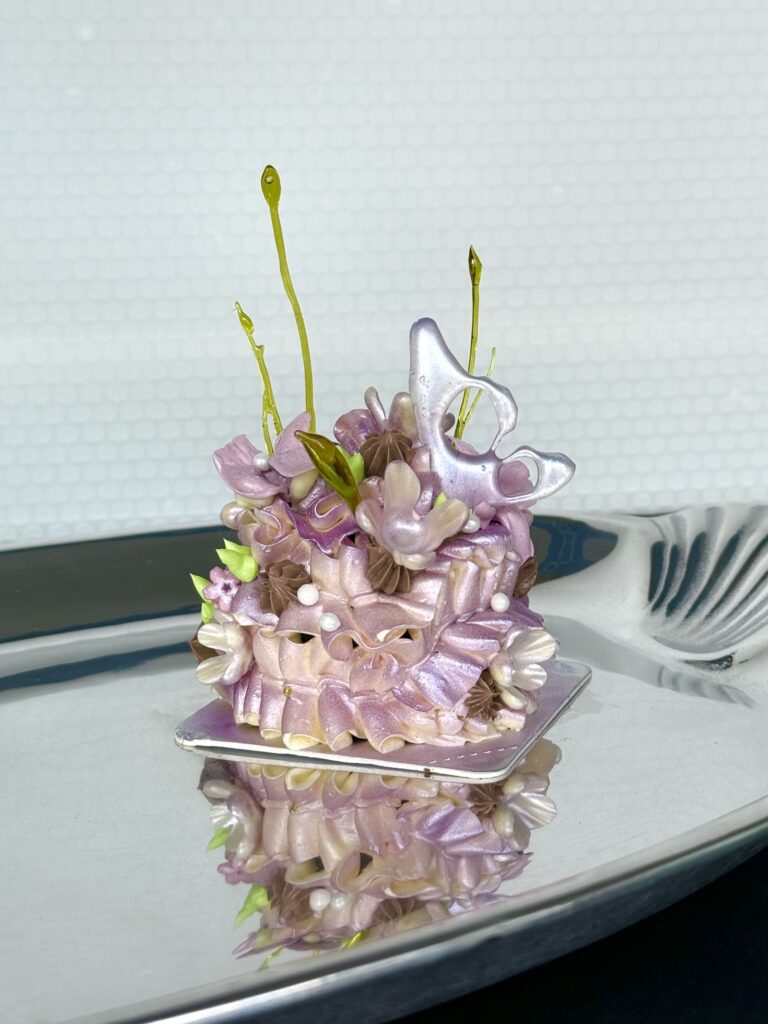
디저트는 왜 아름다울까요? 잠깐의 기쁨을 위해 정성스레 만들고, 눈으로 먼저 감탄하게 하며, 입에 닿는 찰나를 위해 오랜 시간을 들이기 때문이죠. 윤세화 작가는 디저트의 아름다움에 주목하고 그 안에서 조형예술의 가능성을 발견합니다. 그녀에게 디저트는 단순한 음식이 아닙니다. 만드는 과정부터 형태, 질감, 색, 그리고 그것이 놓일 장소와 순간까지 모두가 작품의 일부입니다. 반죽을 다듬는 일도, 장식을 얹는 일도 조각을 다루듯 섬세한 조각작품과도 같습니다.
윤세화는 디저트를 통해 감정을 표현하고, 공간을 구성하며, 삶의 작은 장면을 연출합니다. 그녀의 손에서 디저트는 일상의 장식이 아니라 조형적인 언어가 됩니다. 누군가는 맛으로, 누군가는 형태로, 또 누군가는 그것을 마주한 장소로 기억합니다. 짧은 감각의 시간을 통해 사람들의 하루에 작은 흔적을 남기고 싶다는 것 그것이 그녀가 디저트를 예술로 바라보는 이유입니다.
《기아 디자인 매거진》 15호 Extraordinary에서는 ‘디저트를 먹는다’라는 일상적 행위에 조형성과 의미를 더하는 윤세화 작가의 실험을 소개합니다. 일상에서 피어난 작은 감각이 그녀의 손끝에서 어떻게 예술로 완성되는지 확인해 보시기 바랍니다.
Why are desserts beautiful?
Perhaps because they are crafted with devotion for a fleeting joy, designed to delight the eye before the first bite, and prepared over long hours for a moment that lasts only seconds.For artist Yoon Se Hwa, dessert is more than food. She sees within it the potential of sculpture and form. Every stage, from kneading the dough, shaping textures, choosing colors, to arranging where and when it will be placed, becomes part of a single artwork. Even the smallest gesture, like smoothing a layer of cream or placing a garnish, carries the same delicacy as carving a sculpture.
Through desserts, Yoon expresses emotion, creates spaces, and stages fragments of daily life. In her hands, dessert transforms into a language of form, remembered differently by each person, some by taste, some by shape, and still others by the place they first encountered it. What she hopes for is simple yet profound: to leave a trace in someone’s day through a brief sensory moment. That is why she regards dessert as art. In the 15th issue of Kia Design Magazine, Extraordinary, her work explores how the ordinary act of eating dessert can be imbued sculptural depth and meaning. Here, small sensations from everyday life bloom into art at her fingertips.
- 진지한 실험, 달콤한 발견
윤세화에게 디저트는 놀이다 - 남길 것인가, 순간을 완성할 것인가
그 질문에 답하기 위해 창작을 이어간다 - 왜 그토록 실험을 거듭할까?
그녀를 움직이는 힘은 스스로 즐기는 것 - 개인과 협업 프로젝트 사이,
자신의 작품 세계를 끝없이 탐구하는 시간
- Thoughtful Experiments, Sweet Discoveries
For Yoon Se Hwa, dessert is play - To preserve, or to complete a fleeting moment
She continues creating in search of that answer - Why does she keep experimenting?
Her driving force is the joy she finds in the process - Between Personal and Collaborative Projects,
A Time of Endless Exploration
Editor’s Note
조소를 전공한 윤세화는 한때 젠틀몬스터 공간디자인연구소에서 오브제를 만들던 디자이너였다. 석고와 레진, 다양한 재료를 다루며 형태와 공간의 언어를 익혔던 그녀는 어느 순간, 그 감각을 전혀 다른 무대로 옮겨 놓았다. 바로 주방이었다.
반죽과 크림을 손끝으로 다듬고, 온도와 질감의 미묘한 변화를 조율하며, 그녀는 ‘디저트를 예술로 대하는 방식’을 시작했다. 윤세화에게 디저트는 단순한 조형물이 아니다. 그것은 한 사람의 시선과 손길, 그리고 경험이 머무는 작은 ‘공간’이자, 관객이 오감을 통해 드나드는 경험의 장이다. 한 접시 위에서 형태와 색, 향과 맛이 만나 완성되는 그 순간은 짧지만 강렬한 예술의 시간이다.
《기아 디자인 매거진》 VOL.15 Extraordinary에서는 그녀의 실험, 낯선 조합에서 비롯된 도전, 그리고 실패와 반복 속에서도 멈추지 않는 창작의 과정을 담았다. 작업을 할 때마다 그녀는 스스로에게 묻는다.
“이건 형태로 남을 것인가, 아니면 기억으로 남을 것인가?”
그녀의 실험실 ‘콘페티.야드(CONFETTI.YARD)’에서는 디저트가 예술이 되고, 예술이 일상 속에 스며든다. 끊임없는 탐색 속에서, 그녀의 손끝은 낯설지만 분명한 변화를 만들어낸다.
Editor’s Note
Yoon Se Hwa, who majored in sculpture, once worked as a designer at Gentle Monster’s Spatial Design Lab, creating objects out of Plaster, Resin, and other materials. There, she learned the language of form and space. At some point, she moved that sensibility onto a completely different stage: the kitchen.
Shaping dough and cream with her fingertips, adjusting the subtle changes of temperature and texture, she began what she calls treating dessert as art. For Yoon, dessert is not simply a sculptural object. It is a small space where gaze, touch, and memory converge, a field of experience into which an audience enters with all their senses. On a single plate, form, color, scent, and flavor come together in a fleeting yet powerful moment of art.
The 15th issue of Kia Design Magazine, Extraordinary captures her experiments: daring combinations, challenges born of the unfamiliar, and a creative process that continues through trial and repetition. Each time she works, she asks herself,
“Will this remain as a form, or will it remain as a memory?”
In her studio Confetti Yard, desserts become art, and art seeps back into everyday life. Through relentless exploration, her hands create changes that feel unfamiliar yet undeniably real.
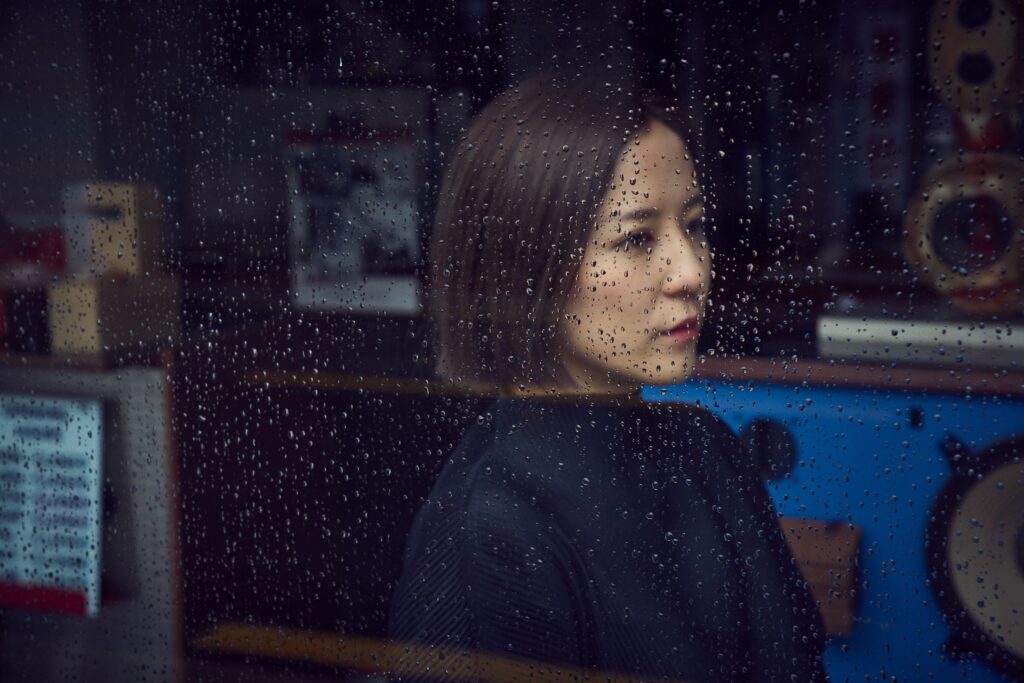
Chapter 01.
진지한 실험, 달콤한 발견
윤세화에게 디저트는 놀이다
Chapter 01.
Thoughtful Experiments, Sweet Discoveries
For Yoon Se Hwa, dessert is play
“음식은 그저 먹는 것”이라는 통념은, 윤세화 앞에서는 힘을 잃는다.
그녀는 디저트를 ‘소(小)예술’이라는 이름으로 진지하게 실험한다.
케이크 한 조각을 조형예술의 무대에 올려, 색을 입히고, 질문을 얹는다.The notion that “food is only meant to be eaten” loses its ground in front of her. Yoon approaches dessert as a form of intimate art, treating it with the seriousness of an experiment. A single slice of cake becomes layered with color, imbued with form, and posing a question to the viewer.
Q. 작가님은 조소를 전공하고, 현재는 디저트를 중심으로 다양한 작업을 이어가고 계십니다. 이렇게 다른 분야를 오가는 작업 속에서, 작가님에게 ‘조형예술’은 어떤 의미인가요?
저에게 조형예술은 ‘만들며 생각하는 일’이에요. 손으로 형태를 만들면서, 그 안에서 스스로에게 질문을 던지는 작업이기도 하죠. 조형은 단순히 시각적인 조각만이 아니라, 그것이 놓이는 맥락과 쓰이는 방식, 그리고 바라보는 시선까지 포함한 전체 구조를 고민하게 만드는 작업이에요. 때로는 물성을 실험하는 일이기도 하고, 때로는 감정을 시각화하는 일이기도 합니다. 형태라는 건 결국 어떤 질문을 시각적으로 풀어내는 방식이고, 그 과정에서 저는 끊임없이 감각하고, 의심하고, 정리하면서 다음 작업으로 나아갑니다. 제게 조형예술은 정답을 말해주는 언어가 아니라, 계속해서 ‘생각하게 만드는’ 언어예요. 그래서 제 작업은 늘 매체와 환경, 그리고 관객과의 관계 안에서 이루어집니다.
Q. 형태라는 것이 디저트로 귀결된 건가요?
조소를 오랜 시간 공부하면서 형태를 다루는 훈련이 되어 있었기에, 손으로 만드는 감각은 저에게 가장 자연스러운 언어였어요. 빵이나 디저트도 형태를 만들고, 시간 안에서 변화하며, 어떤 맥락에 놓이느냐에 따라 다르게 느껴지잖아요. 저는 그 안에서 새로운 표현의 가능성을 보았고, 디저트를 조형의 확장으로 바라보게 됐죠. 그렇게 자연스럽게 작업의 중심이 디저트로 옮겨졌습니다. 결국 제게 중요한 건 ‘무엇을 만드는가’보다 ‘어떻게 만들고, 그것이 무엇을 말하느냐’였던 것 같아요.
Q. You studied sculpture, and now you are working mainly with desserts. As your practice moves between such different fields, what does “sculptural art” mean to you?
For me, sculptural art is about thinking through making. As I shape forms with my hands, I am also asking questions of myself. Sculpture is not only about creating visible objects. It includes the context in which they exist, the way they are used, and the perspectives through which they are seen. Sometimes it is an experiment with material, and sometimes it is a way of giving form to emotions.
A form, in the end, is a way of translating a question into something visual. In that process I am constantly sensing, questioning, and organizing, which leads me toward the next work. To me, sculptural art is not a language that provides answers but a language that keeps me thinking. That is why my work always takes shape within the relationship between the medium, the environment, and the audience.
Q. So is this how your exploration of form eventually led you to desserts?
Yes. Because I had studied sculpture for so long, working with my hands became the most natural language for me. Bread and dessert are also about creating form, transforming over time, and taking on new meanings depending on the context in which they are placed. Within that, I began to see new possibilities for expression, and I came to view dessert as an extension of sculpture. So the center of my practice shifted naturally to desserts.
In the end, what matters to me is not what I make but how I make it, and what it is able to say.
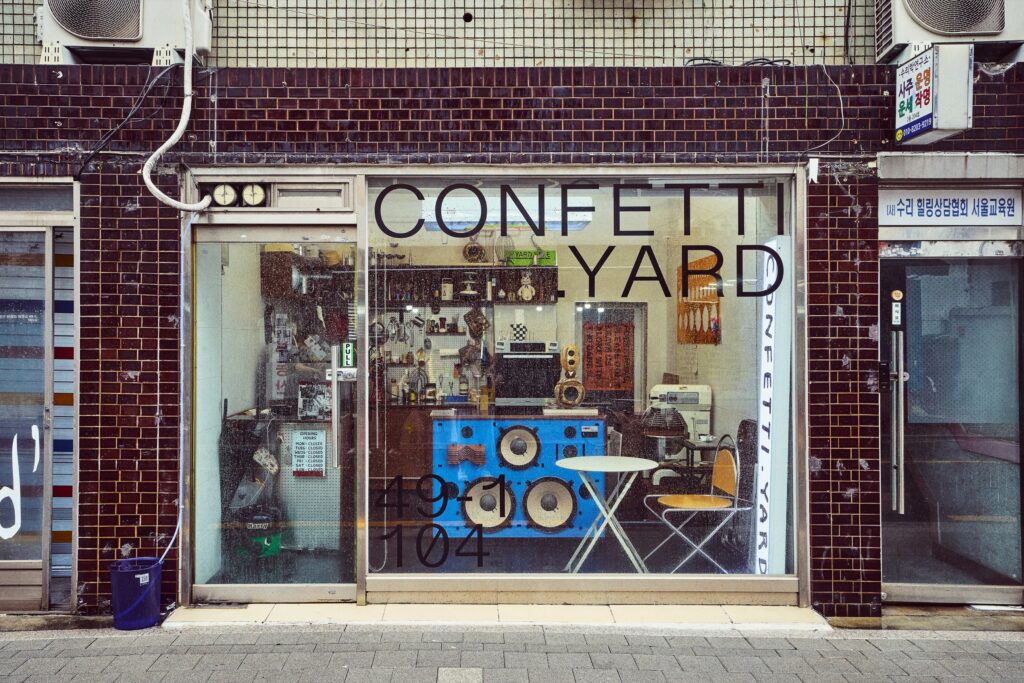
Q. 그 디저트와 조형예술의 창작 무대가 ‘콘페티.야드(CONFETTI.YARD)’인가요?
맞아요. 콘페티.야드는 저에게 실험실이자 무대예요. 공간이 작고 아담해서 처음에는 ‘이 안에서 뭘 할 수 있을까?’ 싶었는데, 오히려 그 한정된 환경이 상상력을 더 자극했어요. 디저트를 조형 언어로 풀어내는 데에서 중요한 건, 그것을 어떻게 놓고 보여주느냐였거든요. 접시 위의 배열, 공간 속 배치, 그리고 그걸 마주하는 사람의 움직임까지—저는 이런 요소들을 모두 포함해 작업이라고 생각합니다.
Q. 창작 무대인 ‘콘페티.야드’라는 이름에는 어떤 의미가 담겨 있나요?
콘페티.야드는 단순히 디저트를 만드는 주방이 아니에요. 제게는 모든 이야기가 시작되고 구현되는 무대이자, 마당 같은 공간이에요. ‘콘페티(CONFETTI)’는 축제에서 뿌리는 색색의 조각 종이를, ‘야드(YARD)’는 마당을 뜻하죠. 이 두 단어를 합친 ‘콘페티.야드’는 말 그대로 다양한 조각들이 흩날리고 뒤섞이면서, 그 안에서 새로운 이야기가 피어나는 공간을 의미합니다.
Q. Is that creative stage for desserts and sculptural art what you call “Confetti Yard”?
Yes. For me, Confetti Yard is both a laboratory and a stage. The space is small and modest, so at first I wondered, what can I really do here? But that very limitation pushed my imagination further. When translating dessert into the language of form, what matters is how it is placed and revealed. The arrangement on the plate, the positioning in the space, and even the movement of the person encountering it are, to me, all part of the work.
Q. What meaning lies behind the name “Confetti Yard”?
Confetti Yard is not simply a kitchen where desserts are made. To me it is a stage where every story begins and unfolds, a kind of open yard. “Confetti” recalls the colorful paper pieces scattered at a celebration, while “yard” suggests a shared open ground. Together, the name evokes a space where fragments of color and form are scattered, mingle, and give rise to new stories.
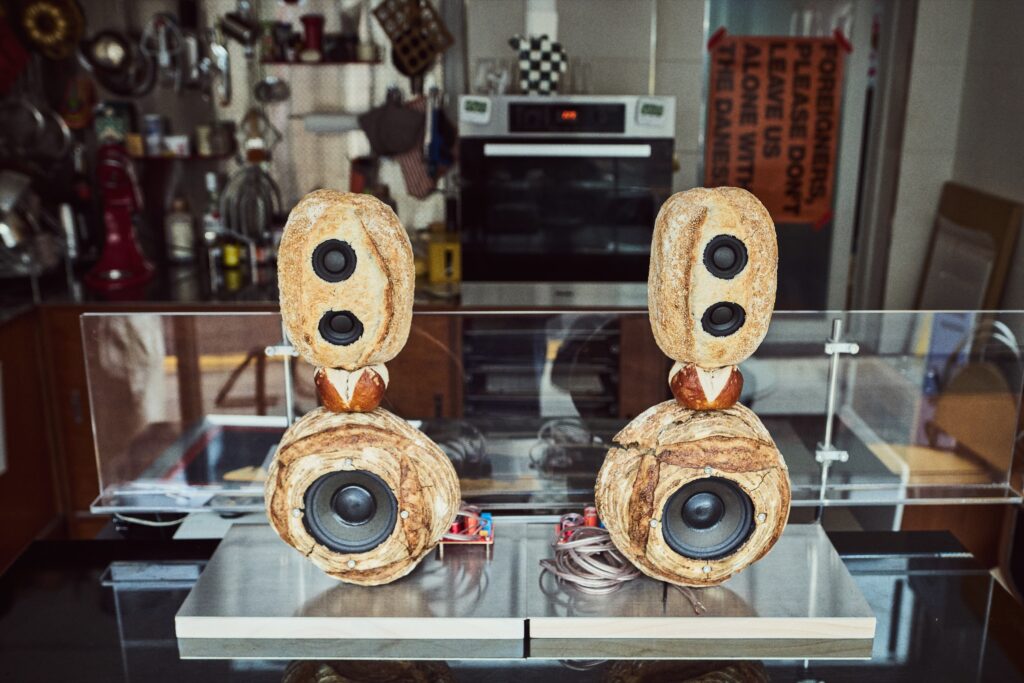
Chapter 02.
남길 것인가, 순간을 완성할 것인가
그 질문에 답하기 위해 창작을 이어간다
Chapter 02.
To preserve, or to complete a fleeting moment
She continues creating in search of that answer
형태만 보면 분명 조형예술과 닮았다.
하지만 디저트는 결국 사라질 운명을 지닌다.
다른 조형 작품처럼 오래 남겨둘 수 없다는 것이 가장 큰 차이다.
그래서 더 궁금해진다. 사라질 것을 알면서도
윤세화는 왜 만들고, 또 어떻게 만들어가는 걸까.At first glance, her work resembles sculpture.
Yet dessert is destined to disappear.
Unlike other sculptural works, it cannot lasts.
That is what makes it different, and that is what deepens the question.
Even knowing it will vanish, why does she keep making it?
Why does Yoon Se Hwa keep creating, and how does she shape her work?
Q. 형태적인 측면에서 조형과 연관이 있지만, 베이킹으로 조형을 하는 건 물성 자체가 다르기에 차이점이 있을 것 같아요.
둘 다 손으로 형태를 만든다는 점에서는 비슷하지만, 조형은 시간과의 관계가 길어요. 물성을 오랫동안 다루고, 형태가 남아 있죠. 생각하고, 다듬고, 천천히 완성해나갈 수 있습니다. 반면 디저트는 그 자체로 일회성이 강하고, 입에 넣는 순간 완전히 사라져요. 그래서 더 강렬한 인상을 남겨야 하죠. 짧은 순간 안에 감각과 이미지를 모두 밀어넣어야 하니까요.
Q. 베이킹은 고려해야 할 것도 많을 것 같은데요.
맞아요. 조형은 제가 의도한 대로 어느 정도 조정이 가능하지만, 베이킹은 매번 다르게 나와요. 온도, 습도, 재료 상태, 반죽 질감 등 어느 하나만 어긋나도 결과물이 달라집니다. 그래서 베이킹은 늘 저에게 도전이에요. 예상대로 나올 때도 있지만, 아무리 해도 안 나오는 날도 있거든요. 그럴 땐 그냥 “그래, 오늘은 이 정도” 하고 포기할 때도 있어요. (웃음) 하지만 그 실패조차도 경험이 되고, 오히려 ‘실패가 더 아름답다’고 느껴지는 순간도 있어요. 방법은 다르지만, 결국 두 작업 모두 ‘형태로 감정을 전한다’는 점에서 같은 길을 걷고 있는 셈입니다.
Q. In terms of form, your work connects to sculpture, yet baking must differ greatly in its material nature.
Both involve shaping with the hands, but sculpture has a long relationship with time. The material can be worked slowly, refined over days, and preserved as something enduring. Dessert is the opposite. It is intensely ephemeral, vanishing the moment it is eaten. That is why it must leave a stronger impression. All sensations and images have to be condensed into a single fleeting moment.
Q. Baking also seems to involve many unpredictable variables.
Exactly. Sculpture can be controlled to a degree, but baking never comes out the same way twice. Temperature, humidity, the state of the ingredients, the texture of the dough, each one can alter the result. That constant unpredictability makes baking a challenge. Sometimes it matches my intention, other times it refuses to cooperate. On those days I simply accept it and say, “This is enough for today.” (laughs) Yet even failure becomes part of the experience, and at times I find that failure can be even more beautiful. The methods may differ, but both sculpture and baking ultimately share the same path: conveying emotion through form.
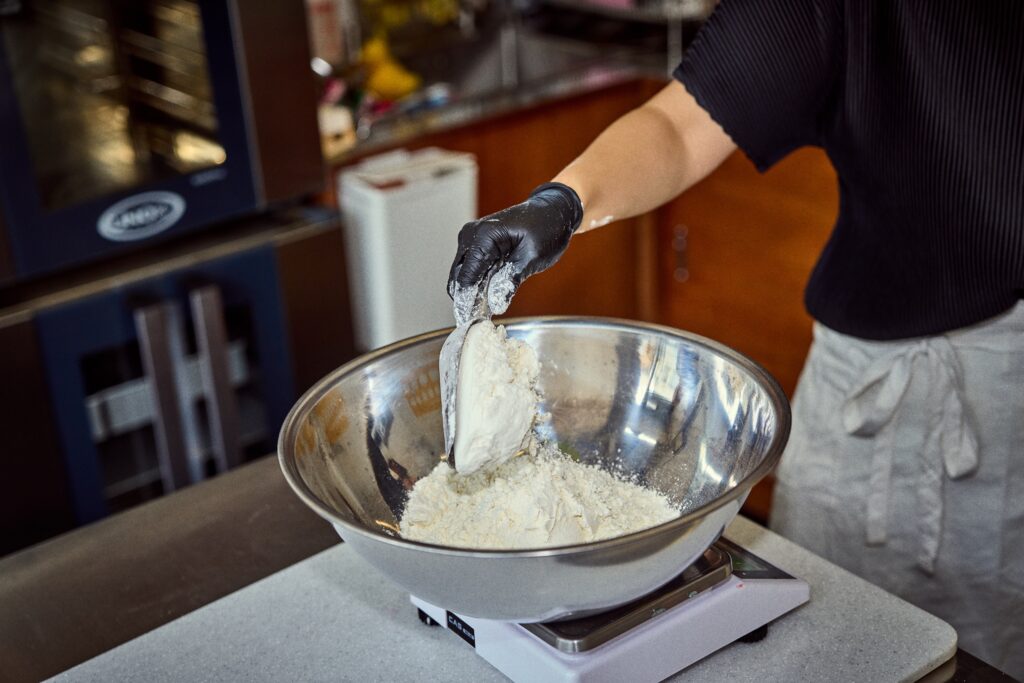
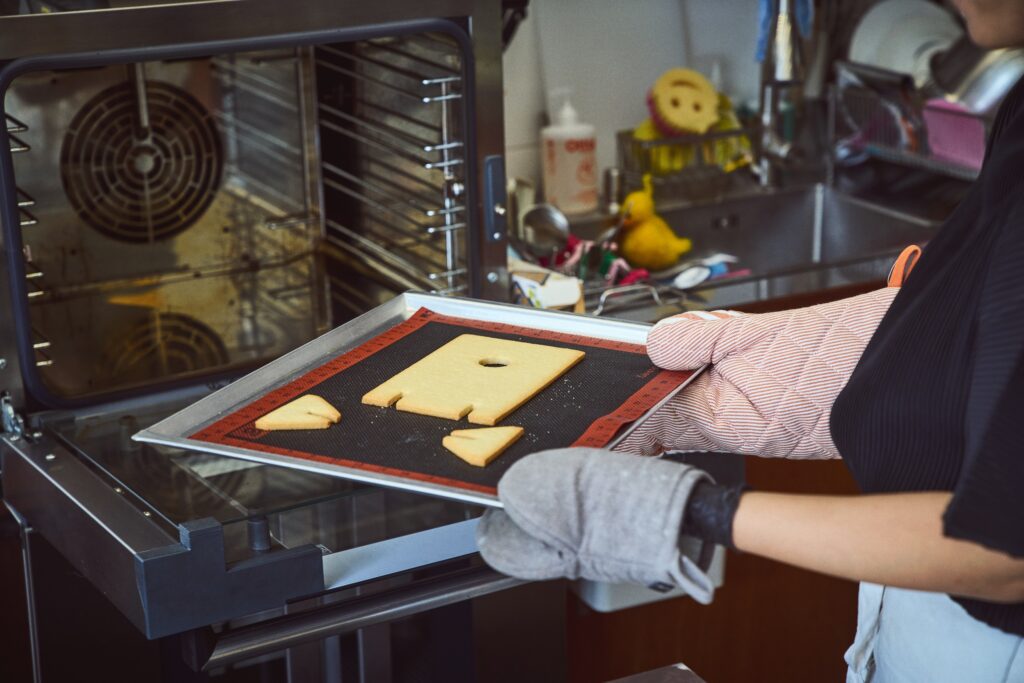
Q. 베이킹을 기반으로 하기 때문에 보존성 등도 고려해야 하잖아요. 작업 과정이 꽤 까다로울 것 같습니다.
결정적인 차이는 ‘보존성’이에요. 조각은 시간이 흘러도 남아 있지만, 디저트는 유통기한이 있죠. 사라지기 때문에 오히려 그 순간을 더 아름답게 담아내야 한다는 강박이 생기기도 해요. 브랜드 협업에서는 또 다르게 접근해요. 그럴 때는 ‘마케팅’이라는 목적을 의식하게 되죠. 예전 젠틀몬스터에서 일할 때부터 그런 관점이 몸에 배어 있었던 것 같아요. 그래서 디저트의 맛뿐만 아니라 SNS에서 어떻게 ‘보일 것인가’, 어떻게 ‘기억에 남을 것인가’도 중요합니다. 그래서 사진이나 영상에 담겼을 때 임팩트가 있는지, 화면을 뚫고 나오는 첫인상이 있는지를 먼저 생각하죠. 그럼에도 불구하고 주문자가 원하는 방식을 최대한 살려서 하려고 하되 그 안에서 저만의 색이나 조형미를 어떻게 녹여낼지에 대하여 많은 고민을 거듭하게 됩니다. 제 개인작업은 저의 즐거움과 만족을 찾아 진행하고 있지만 어떠한 작업이든 저만의 표현들을 녹여낼 수 있는지 없는지가 가장 중요한 부분이죠.
Q. 그렇다면 작업 전에 ‘남기느냐, 임팩트를 줄 것이냐’에 대한 기준을 세우는 편인가요?
맞아요. 작업을 시작하기 전 스스로에게 던지는 첫 질문이 바로 그거예요. 이건 오래 남길 작업인가, 아니면 순간을 담아낼 작업인가? 그 결정에 따라 재료와 작업 방식이 완전히 달라집니다. 오래 남길 작업이라면 재료의 내구성, 보존 방법, 색의 안정성까지 고려하죠. 반대로 순간을 위한 작업이라면 임팩트와 감정의 여운에 집중합니다. ‘그 순간을 얼마나 예쁘게, 깊이 있게, 강렬하게 남길 수 있을까?’를 고민하며, 때로는 더 감각적이고 감정적인 재료를 사용하기도 해요. 이건 브랜드 협업에서도 중요한 기준이에요. 요즘은 사진이나 영상으로 퍼지는 속도가 빠르잖아요. 그래서 ‘남기는 방식’이 꼭 물리적인 것만을 의미하지 않아요. 어떤 이미지를, 어떤 감정을 남길 것인가—이런 비물질적인 ‘잔상’도 중요한 결과물이라고 생각합니다. 결국 제가 만드는 건 형태이기도 하지만, 기억이기도 하니까요.
Q. 그런데 계속 생각만 할 수는 없잖아요. 결단은 쉽게 내리는 편인가요?
맞아요. 저는 일단 손이 움직여야 생각이 열리는 타입이에요. 머릿속에만 담아두면 생각이 과하게 쌓여 정리가 안 되거든요. 그래서 작업할 땐 우선 만들어봅니다. 그러면 예상치 못한 재료의 반응, 흐트러지는 구조, 갑자기 어울려 버리는 조합 같은 것들이 흥미롭게 다가와요. 저는 늘 ‘다르지만 비슷한 물성을 어떻게 대체할 수 있을까?’를 고민합니다. 예를 들어, 석고 반죽을 베이킹의 크림으로 바꿔본다든가, 스피커의 나무 박스를 빵으로 만든다든가 하는 상상에서 시작하죠. 조소 작업에서 익숙했던 재료와 베이킹 재료는 물성이나 배합 방식이 의외로 닮아 있는 경우가 많아요. 그래서 그 전환 과정 자체가 제게는 하나의 놀이처럼 느껴지기도 합니다.
Q. Since your work is based on baking, you must also consider issues of preservation. The process sounds quite demanding.
The decisive difference lies in preservation. A sculpture remains through time, but a dessert comes with an expiration date. Because it eventually disappears, there is an almost compulsive urge to capture its beauty in the fleeting moment. Brand collaborations call for a different approach. In those cases, the purpose of marketing becomes impossible to ignore. That perspective has been ingrained in me since my time at Gentle Monster. It is not only about the taste of the dessert but also about how it will appear on social media, how it will be remembered. I ask myself whether the work has visual impact when photographed or filmed, whether it delivers a striking first impression that breaks through the screen. At the same time, I strive to honor the client’s wishes as much as possible, while continually reflecting on how to infuse my own sense of color and sculptural aesthetics. My personal projects are pursued for my own joy and satisfaction, but in the end, the crucial measure is whether I can leave my own expression in any work I create.
Q. Do you set a clear standard beforehand about whether the work should last or deliver an immediate impact?
Yes. That is always the first question I ask myself before beginning Is this something meant to endure, or is it something meant to capture a moment? The answer changes everything, from the choice of material to the method of making.
If the work is to last, I consider durability, preservation, and the stability of color. If it is for the moment, I concentrate on impact and emotional resonance. I ask myself how beautifully, how deeply, how intensely that instant can be remembered. Sometimes I even use more sensory and emotional materials to achieve that. This question is also central to brand collaborations. Today images and videos spread so quickly that preservation no longer refers only to something physical. What image, what feeling will remain, those intangible traces are just as important. In the end, what I create is not only form but also memory.
Q. But you cannot stay in thought forever. Do you make decisions easily?
Yes. I am the type whose ideas open up once my hands start moving. If I keep everything in my head, the thoughts pile up and never settle. So I begin by making. That is when unexpected unfold: a surprising reaction of a material, a structure collapsing, or an accidental combination that suddenly works. I constantly ask myself how I might substitute one material for another that is different yet somehow similar. I might replace plaster with baking cream, or turn the wooden box of a speaker into bread. The materials and mixtures I knew from sculpture often have surprising parallels in baking. That shift itself feels like a kind of play to me.
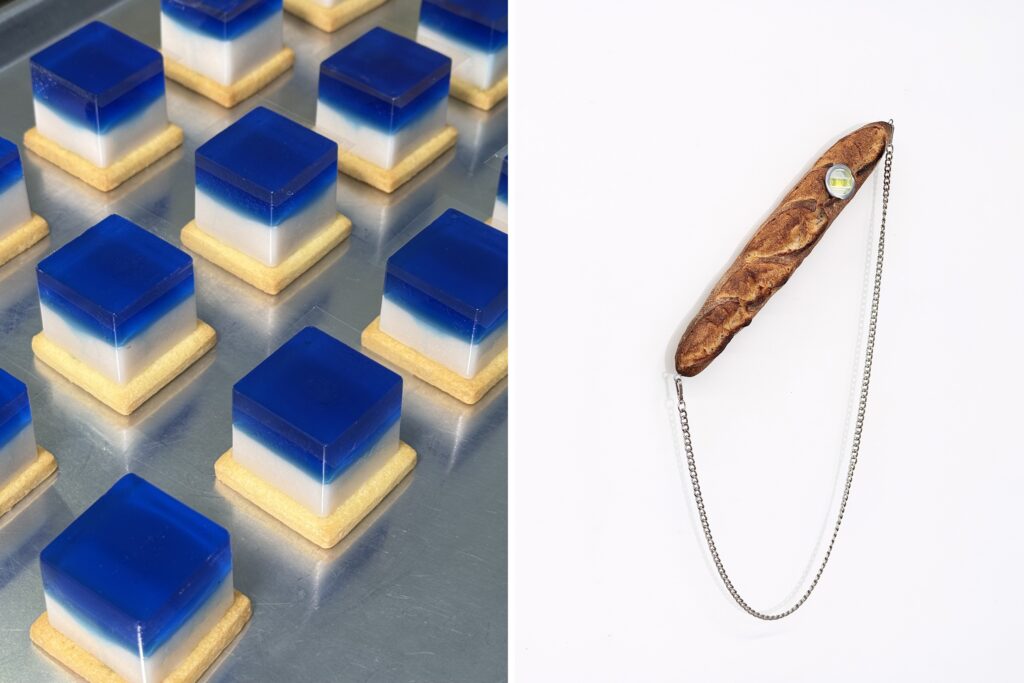

Chapter 03.
왜 그토록 실험을 거듭할까?
그녀를 움직이는 힘은 스스로 즐기는 것
Chapter 03.
Why does she keep experimenting?
Her driving force is the joy she finds in the process
작품을 시작하기 전, 그녀의 기준은 하나다.
“정말 독창적인가?” 그 답을 얻을 때까지 실험을 멈추지 않는다.
실패는 쓰다. 그러나 시도조차 하지 않는 건 더 쓰다.
그래서 그녀는 다시 실험한다.Before beginning a work, she has one standard.
“Is this truly original?” Until she finds the answer, she does not stop experimenting. Failure is bitter, but not trying at all is far more bitter.
And so she experiments again.
Q. 늘 선택을 한다는 건 성공과 실패라는 답이 나올 수밖에 없는데, 실패에 대한 압박감은 없나요?
있죠. 실패하면 저도 아파요. 그런데 그 실패 덕분에 전혀 예상하지 못했던 새로운 형태가 탄생하기도 해요. 그래서 저에게는 고민, 실패, 수정, 또 실패… 이런 과정이 작업의 일부예요. 필연적인 순환이라고 생각해요.
Q. 실패를 피하기 위한 작가님의 노하우는 무엇인가요?
결국 실험의 반복이에요. 이 재료를 어떤 온도로 몇 분간 구울 것인가부터 시작해서, 형태를 어디까지 밀어붙일 수 있을지, 이 조합이 어떤 질감과 색을 낼지… 작업 하나가 나오기까지 수십 번은 실험을 반복하죠. 게다가 저는 단순히 예쁘거나 맛있는 디저트를 만드는 게 아니라, 그 안에 어떤 이야기를 담을 수 있을지를 가장 먼저 생각해요. 예를 들어 ‘감정을 굽는다’는 마음으로 작업할 때, 과연 이 재료로 만들었을 때 내가 원하는 것이 나올까? 그렇게 고민하죠. 하지만 이것은 ‘실패하지 않기 위한 고민’이라기보다 ‘내가 진짜 말하고 싶은 것을 찾기 위한 탐색’에 가깝습니다.
Q. 실패하면 아프기도 하면서, 그렇게 도전하고 실험하는 원동력은 어디에서 오나요?
저에게 가장 큰 원동력은 ‘즐거움’이에요. 저는 실험적인 것을 좋아하고, 도전하는 것을 즐기는 성향이에요. 그래서 새로운 작업을 시도하고, 그걸 해냈을 때 오는 성취감이 정말 커요. 그때 느껴지는, 도파민이 분출되는 듯한 감정이랄까요. 그런 성취감에 자꾸 중독되는 것 같아요. 그리고 가장 중요한 건, 제가 무엇을 정말 좋아하는지, 어떻게 만들고 싶은지를 여전히 실험해보고 있다는 점이에요. 그 탐색이 끝나지 않았기 때문에 지치지 않고 계속할 수 있는 거죠. 어떤 형태를 만들든, 결국 그 안에는 제 감정과 생각이 담겨 있어야 하니까요. 그러기 위해 저는 계속 스스로에게 질문을 던지고, 손으로 답을 만들어냅니다. 그 과정이 제게는 너무 자연스럽고, 또 저를 살아 있게 만들어주는 일이기도 해요.
Q. 놀이처럼 즐기기에 작품이 유독 독창적인 것 같은데, 어떻게 생각하세요?
그럴 수도 있을 것 같아요. 저는 늘 낯선 걸 해보고 싶어 했고, 남들이 가지 않은 방향에 끌리니까요. 베이킹에 대한 전문지식이 부족한 데에서 오는 무모함 일 수도 있지만, 그렇기에 더 자유 롭게 표현할 수 있는 것 같아요. 그냥 밀고 나가는 힘이죠. 지금의 작업들도 결국 그런 성향에서 비롯됐다고 볼 수 있어요. 베이킹으로 조형예술을 한다는 건, 사실 어디에도 답이 없어요. 가이드도 없으니까요? 그런데 저는 그게 오히려 재미있었어요. ‘어디까지 가볼 수 있을까? 무너질 수도 있지만, 어쩌면 아주 새로운 문을 열 수 있지 않을까?’라는 상상을 품고 달리는 느낌이랄까요. ‘깡’이라는 단어를 꺼낸 것도, 뭔가 하나에 몰두하면서 생기는 내적인 힘, 그리고 밀어붙이는 태도를 스스로 응원하고 싶어서였던 것 같아요.
Q. Every choice seems to carry the possibility of success or failure. Do you ever feel pressure about failure?
Of course. Failure hurts. But at times failure gives birth to forms I could never have predicted. For me, questioning, failing, correcting, and failing again are all part of the work. I see it as an inevitable cycle.
Q. Do you have a method to avoid failure?
What ultimately matters is repetition. I test everything again and again, from the temperature and time for baking to how far I can push a shape or what textures and colors certain combinations might produce. Dozens of trials go into a single work. And I am not only making desserts that look pretty or taste good. I begin by asking what kind of story the piece can carry. For example, if I approach it with the thought of “baking an emotion,” I ask whether the material I choose will deliver what I want. This is less about avoiding failure and more about searching for what I truly want to express.
Q. If failure is painful, what gives you the drive to keep challenging and experimenting?
The greatest drive for me is joy. I enjoy experimenting and I enjoy taking risks. The sense of accomplishment when a new attempt works is immense, almost like a rush of dopamine. I think I have become addicted to that feeling. What matters most is that I am still exploring what I truly love and how I want to create. Because that exploration is not finished, I can keep going without losing energy. Whatever form I create, it must carry my emotions and thoughts. That is why I continue asking questions and answering them with my hands. This process feels natural to me and it keeps me alive.
Q. Perhaps it is because you enjoy it like play that your work feels so original. What do you think?
That may be true. I have always wanted to try unfamiliar things and felt drawn to directions others might avoid. To some it might look reckless, but I see it as grit, a force that pushes me forward. My current work has grown out of that trait.
Creating sculptural art through baking has no clear answers. But that is exactly what makes it interesting. I feel as if I am running with the thought, “How far can I go? It may collapse, but what if it opens a completely new door?” I used the word grit because it expresses the inner strength and persistence that come from being absorbed in something, and also as a way of cheering myself on.
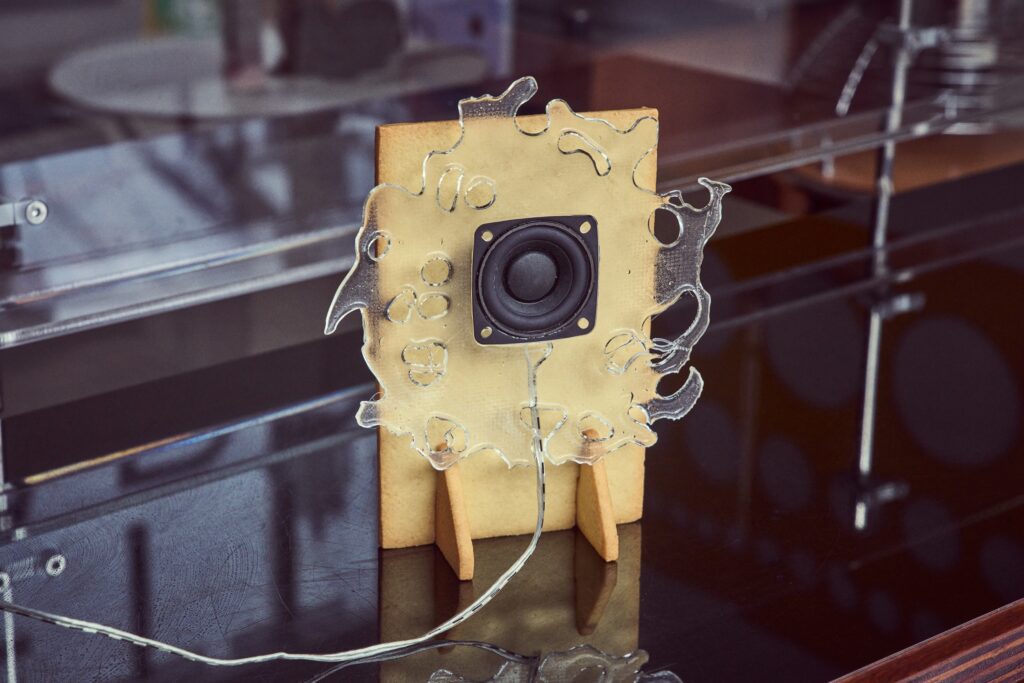
Chapter 04.
개인과 협업 프로젝트 사이,
자신의 작품 세계를 끝없이 탐구하는 시간
Chapter 04.
Between Personal and Collaborative Projects,
A Time of Endless Exploration
개인 작업과 커머셜 작업 그 경계 어딘가에서,
윤세화는 여전히 자신의 작품 세계를 탐구한다.
끝을 정하지 않은 채, 유한한 재료로 무한한 가능성을 빚어내며
매 순간 새로운 형태와 감각을 실험한다.Somewhere between personal work and commercial collaborations,
Yoon Se Hwa continues to explore her own artistic world.
With no fixed end in sight, she shapes infinite possibilities from finite materials, experimenting with new forms and sensations at every moment.
Q. 자신만의 작품 세계를 위해 브랜드 제안 작업과 개인 작업을 굉장히 많이 하고 계신 것 같아요. 브랜드 제안 작업 중 인상적인 사례를 꼽는다면 무엇이 있을까요?
제가 가장 애정하는 콜라보는 역시 나이키의 Air Max Dn8이에요. 제가 나이키의 팬이기도 하고, 단순한 의뢰가 아니라 ‘아티스트’로서 함께하게 된 프로젝트였기 때문에 제 표현을 훨씬 더 자유롭게 풀어낼 수 있었어요. 그래서 그만큼 더 많은 에너지를 쏟게 된 것 같아요.
Q. 그 프로젝트에 몰입하기 위해 특별히 기울였던 노력이나 고민의 과정이 있다면 들려주세요.
에어맥스라는 제품의 ‘움직임’과 ‘에어감’을 표현하는 것이 가장 중요한 미션이었어요. 저는 이를 먹을 수 있는 디저트가 아닌, 시간에 따라 형태가 변화하는 구조로 구현해 보고 싶었어요. 그래서 실제로 움직이는 버터 조각이나 빵 같은 재료를 사용해 제품의 역동성을 표현했죠. 그런데 생각보다 버터가 빨리 녹는 거예요. 실내 온도의 영향이 컸어요. 매일 녹은 자국을 닦고, 형태를 다시 만들고, 수습하는 일을 반복해야 했죠. 쉽지 않았지만, 그 불안정성 자체가 오히려 이 프로젝트의 매력을 더해줬던 것 같아요. 디저트라는 물성이 가진 한계와 가능성을 동시에 실험할 수 있었거든요. 개인적으로도 굉장히 인상 깊었고, 앞으로도 오래 기억에 남을 작업입니다.
Q. You seem to take on many brand commissions alongside your personal work. Could you share a collaboration that left a strong impression on you?
The collaboration I cherish most is with Nike on the Air Max Dn8. I am a big fan of Nike, and this was not just a commission but a project where I was invited to participate as an artist. That gave me the freedom to express myself much more openly, and I think that is why I poured so much energy into it.
Q. Was there a particular effort or challenge you faced in immersing yourself in that project?
The key mission was to capture the sense of movement and the feeling of air that define the Air Max. I wanted to express this not through edible dessert, but as a structure that would transform over time. I used materials like moving pieces of butter and bread to bring out the dynamism of the product.
The challenge was that the butter melted faster than I expected, heavily affected by the room temperature. Every day I had to wipe away the traces, reshape the forms, and restore the work. It was not easy, but that instability itself added to the appeal of the project. It allowed me to test both the limitations and possibilities of dessert as a material. Personally it was an unforgettable experience, and one that will stay with me for a long time.
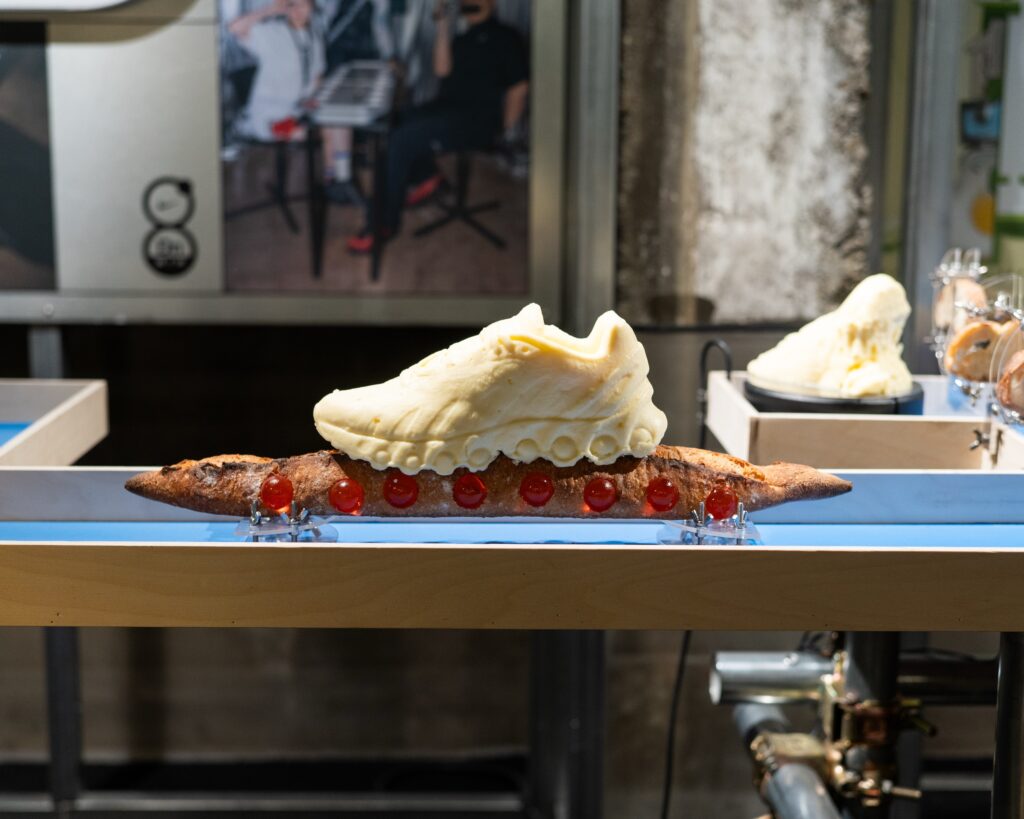
Q. 케이크와 케이터링 작업 모두 활발히 하고 계신데요, 두 작업에 접근하는 방식은 어떻게 다른가요?
케이크는 한때 개인 주문을 많이 받았지만, 지금은 저만의 표현에 집중하기 위해 방향을 조금 바꿨어요. 주문자의 기대와 제가 표현하고 싶은 이미지가 어긋나는 경우가 많았거든요. 서로 만족하기 어려운 상황이 반복되다 보니, 점점 그 과정이 조심스럽고 피로하게 느껴지더라고요. 무엇보다 ‘예쁘고 맛있는 케이크’를 원하는 시선과 ‘조형적 실험을 하고 싶은 저의 욕구’ 사이에 간극이 있었어요. 그래서 지금은 케이크를 작업 재료로 쓰되, 제 감각과 언어로 표현할 수 있는 프로젝트에만 한정하고 있어요.
반면 케이터링은 훨씬 더 자유롭습니다. 저는 케이터링을 하나의 ‘테이블 조형’으로 바라봐요. 단순히 음식을 만드는 데 그치지 않고, 전체 공간과 경험을 설계하는 작업이라고 생각하죠. 브랜드나 행사, 대상과의 관계를 먼저 고민하고, 그에 맞춰 음식의 형태와 구조, 사용하는 그릇과 테이블의 조합까지 계획해요. 때로는 그릇이나 테이블을 직접 제작하기도 합니다. 음식을 시각적·공간적 오브제로 접근하면서도, 먹는 경험이 하나의 연출처럼 흐를 수 있도록 구성하는 거죠. 결국 케이크와 케이터링은 모두 ‘형태를 통해 감각을 구성하는 일’이지만, 케이터링은 더 넓은 무대에서 조형성과 관계성을 펼칠 수 있는 작업이라, 저에게는 더 큰 실험의 장이 되어주고 있어요.
Q. You are active both in cake design and catering. How do you approach these two forms of work differently?
At one point, I received many personal cake orders, but now I focus more on projects where I can express my own language. With commissions, there were often gaps between the client’s expectations and the images I wanted to create. That mismatch led to repeated situations where neither side felt fully satisfied, and the process began to feel cautious and even exhausting. Most of all, there was a divide between the desire for a “pretty and delicious cake” and my own drive to experiment sculpturally. So these days, I still use cake as a material, but only in projects where I can shape it according to my own sensibility and voice.
Catering, on the other hand, is much freer. I see it as a kind of table sculpture. It is not just about preparing food but about designing an entire space and experience. I begin with the relationship to the brand, the event, or the audience, and from there I plan the form and structure of the dishes, the choice of plates, and the composition of the table itself. Sometimes I even design or build the vessels and tables. The idea is to treat food as both a visual and spatial object while orchestrating the act of eating as a staged experience.
In the end, both cakes and catering are about composing sensations through form. But catering offers a wider stage where form and relationships can unfold, which makes it an even greater field of experimentation for me.
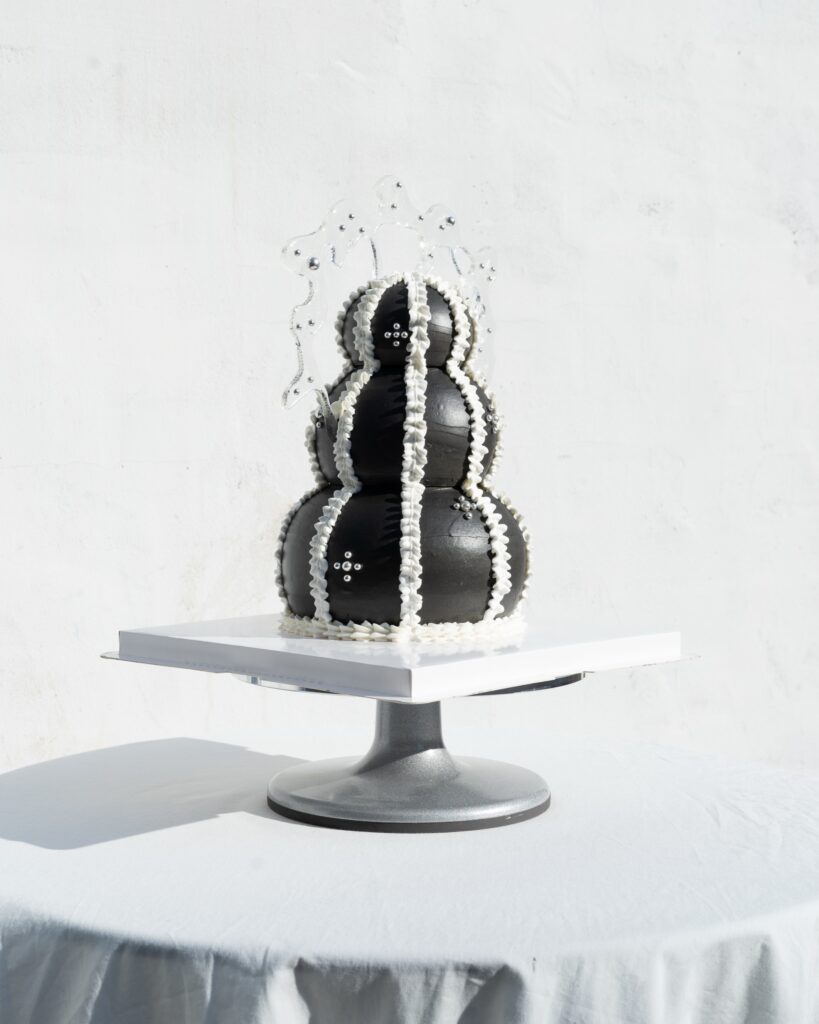
Q. 개인과 협업을 병행하고 계시는데, 그 이유는 무엇인가요?
저는 개인 작업과 협업 작업을 굳이 구분 짓지 않아요. 제가 어떤 것을 표현하는지에 더 중점을 두기 때문이에요. 사실 제 작업을 ‘딱 예술이다’라고 단정 짓기는 어려울 수도 있어요. 예술일 수도 있고, 디자인일 수도 있으며, 누군가에겐 그냥 맛있는 음식일 수도 있죠. 그래서 하나의 정해진 형태보다는, 계속 변하고 실험하는 ‘움직이는 과정’에 더 가깝다고 생각해요. 지금도 물성에 대한 실험을 이어가고 있어요. 음식이라는 재료가 미식의 영역을 넘어 어디까지 확장될 수 있을지, 예술이나 문화적 맥락 속에서 어떤 가능성을 가질 수 있을지를 탐색하는 중이죠.
Q. 자신만의 작품 세계를 만들어가는 중이라는 이야기로 들리는데요.
사실 저는 아직 어디까지 갈 수 있을지, 저 스스로도 지켜보고 있는 중이에요. 사업도 하고, 예술적인 작업도 하면서 앞으로는 문화와 패션 등 더 다양한 영역을 아우르는 스튜디오를 만들고 싶은 마음도 있어요. 혼자서는 어려울 수 있으니, 저처럼 실험하고 도전하는 걸 좋아하는 사람들과 함께 무언가를 만들어가고 싶어요. 확정된 목표가 있는 것은 아니에요. 제 앞에 놓인 선택지들을 하나씩 마주하며, 그때그때 제가 할 수 있는 일을 선택해 가는 방식으로 작업을 이어가고 있습니다.
Q. You balance both personal and collaborative projects. Why do you choose to work in this way?
I do not draw a strict line between them, because my focus is always on what I am expressing. It is not easy to define my work as purely art. For some it may feel like art, For others design, and for others simply delicious food. For me, it is less about fixing on one form and more about shifting process that keeps moving and experimenting. I continue to explore the materiality of food, to see how far it can extend beyond the realm of gastronomy, and what possibilities it might hold within art and cultural contexts.
Q. It sounds as though you are in the process of building your own artistic world.
That is true. I am still watching to see how far I can go. Alongside my practice, I also run a business, and in the future I hope to build a studio that connects more diverse fields such as culture and fashion. Of course, I cannot do it alone. I want to work with others who share the same spirit of experimentation and challenge. I do not have a fixed goal, but I move forward by facing each choice as it comes and committing fully to what I can do at each step.
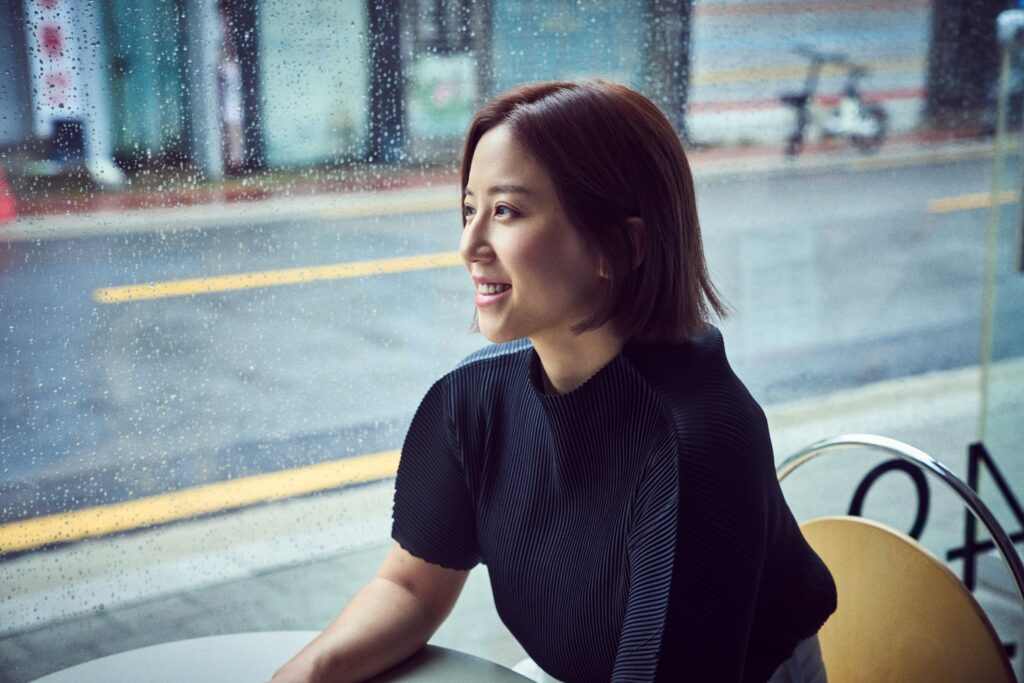
Q. 그럼 작가님이 진정으로 원하는 건 무엇일까요?
글쎄요, 제가 정확히 어디로 가고 있는지는 아직 잘 모르겠어요. 하지만 분명한 건, 계속해서 무언가를 만들어가고 싶다는 마음이에요. 크리에이터로서 다양한 것을 경험하고, 그 경험을 바탕으로 새로운 시도를 이어가는 것, 그게 제가 원하는 삶의 방식인 것 같아요. 그러기 위해 저는 세상 속에서 저를 잃지 않으려 해요. 스스로 재미를 느끼고, 그 즐거움을 놓치지 않으려는 태도, 그것이 제가 실험하고 도전하며 탐구할 수 있는 원동력이 되거든요. 흘러가는 것들을 있는 그대로 받아들이되, 그 안에서 제 방식대로 다시 구성해보는 것, 그 과정 자체가 제게는 중요한 작업이에요.
Q. 끝으로, 가까운 미래든 언젠가 꼭 해보고 싶은, 윤세화 작가만의 독창적인 프로젝트가 있다면 소개해 주세요.
저는 뭔가 큰 계획을 세우고 움직이는 편은 아니에요. 전략적으로 인생을 설계하기보다는, 아직 열리지 않은 게임 맵처럼 “어디로 이어질까?” 하며 궁금해하며 살아가는 쪽이에요. 그래서 제게는 현재의 모든 작업이 동시에 ‘준비 중’이고, ‘진행 중’이며, 또 어쩌면 완성된 결과일 수도 있어요. 그런데 조만간 해보고 싶은 게 하나 있어요. 조금 엉뚱하게 들릴 수도 있지만, 길고양이를 위한 케이터링이에요. (웃음) 그냥 밥을 주는 게 아니라, 정말 정성스럽게 상을 차려서 고양이들이 식사하는 모습을 영상이나 사진으로 담아보고 싶어요. 그 모습을 예쁘게 기록하는 것만으로도 재미있을 것 같고, 제 작업을 바라보는 새로운 시선이 생길 것 같거든요. 그리고 늘 생각해요. 누구나 할 수 있는 방식보다는, 남들이 쉽게 선택하지 않는 접근을 해보고 싶다고요. 꼭 거창하지 않아도, 프로젝트마다 저만의 도전을 하나씩은 담고 싶어요. 써보지 않았던 소재를 써본다든가, 검색해도 나오지 않는 방식으로 시도해본다든가요. 그게 제게는 작은 성취감이고, 계속 작업을 즐길 수 있는 이유인 것 같아요.
Q. Then what is it that you truly want as an artist?
Honestly, I am not entirely sure where I am heading. What I do know is that I want to keep creating. As a creator, I want to experience many different things and use those experiences as fuel for new attempts. That feels like the way of life I want. To do that, I try not to lose myself in the world around me. I hold on to the sense of fun and the joy that comes with it, because that is what drives me to experiment, to take risks, and to explore. I accept things as they flow, yet always try to reconfigure them in my own way. That process itself is an essential part of my work.
Q. Lastly, is there a unique project of your own that you hope to realize in the near future or someday?
I am not someone who plans far ahead. Rather than designing my life strategically, I live with a sense of curiosity, like exploring an unopened game map and wondering where the path might lead. To me, every work I do now is at once in preparation, in progress, and in some sense already complete. That said, there is one idea I want to try soon. It might sound a little eccentric, but I would like to create a catering service for stray cats. (laughs) Not just putting food out for them, but setting a proper table with care and recording the way they dine, in photos or video. I think it would be fun, and it might offer a new perspective on my work.
I always tell myself that I want to choose approaches others might not take. It does not have to be grand. With each project, I want to include at least one challenge, whether that means using a material I have never tried before or attempting something in a way you will not find in a search. Those are the moments that give me small but real satisfaction, and they are why I can continue to enjoy creating.
윤세화
윤세화는 한때 ‘젠틀몬스터’ 공간 디자인 연구소 공간팀에서 탬버린즈 직장 생활을 했지만, 매일 반복되는 루틴보다 정답은 없지만 실험을 즐길 수 있는 길을 선택했다. 그렇게 디저트 조형예술의 세계로 발을 내디뎠다. 현재 디저트 스튜디오 콘페티.야드(CONFETTI.YARD)를 운영하며, 먹을 수 없는 디저트로 작품을 만들기도 하고, 나이키, 템버린즈 등과 협업하며, 전시 공간부터 케이터링 테이블까지, 다양한 무대 위에서 윤세화만의 조형예술을 실험하고 확장해 나간다.
Se Hwa
She once worked at Gentle Monster’s Space Design Lab, Space Team, but chose to leave behind the daily routine of corporate life to pursue a path with no fixed answers, a path where she could embrace experimentation. That decision led her into the world of dessert as sculptural art. Today she runs her dessert studio Confetti Yard, where she creates works from inedible desserts, collaborates with brands such as Nike and Tamburins, and experiments with form across diverse stages, from exhibition spaces to catering tables.
Epilogue
윤세화 작가에게 실험은 특별한 이벤트가 아니라 일상의 태도다. 새로운 재료를 만지고, 익숙한 형태를 비틀며, 아직 이름 붙이지 못한 작품과 마주한다. 그녀는 매일의 작업 속에서 자신만의 리듬으로 실험을 이어간다. 완벽을 향해 나아가기보다, 미완의 틈에서 피어나는 우연과 낯섦을 즐긴다. 남들이 쉽게 선택하지 않는 방식, 누구도 시도하지 않았던 조합 속에서 새로운 가능성을 찾는다. 그렇게 사소한 일상은 서서히 조형의 언어로 변해간다.
《기아 디자인 매거진》은 이번 인터뷰를 통해 예술과 삶의 경계를 유연하게 넘나들며 자신만의 세계를 구축하는 한 작가의 모습을 담았다. 윤세화의 작업은 아직 완성되지 않았고, 어쩌면 끝나지 않을지도 모른다. 그녀의 실험을 하나의 완결된 결과물이 아닌, 계속 이어지는 과정으로 바라봐 주길 바란다. 그 안에서 작가가 남긴 질문과 감각, 그리고 조용히 스며든 유머를 발견하길 기대한다.
Epilogue
For Yoon Se Hwa, experimentation is not a special event but an attitude toward everyday life. She explores new materials, reshapes familiar forms, and encounters works that have yet to be named.. In her daily practice she continues experimenting at her own rhythm. Rather than striving for perfection, she enjoys the chance encounters and strangeness that bloom in the gaps of the unfinished. She seeks new possibilities in methods few would choose and in combinations no one has yet tried. In this way, small moments of daily life slowly transform into a language of form.
In this issue, Kia Design Magazine captures an artist who moves fluidly across the boundaries of art and life to build her own world. Yoon’s work is not yet complete, and perhaps it never will be. We invite you to view her experiments not as final results but as an ongoing process. Within it, we hope you discover the questions she leaves behind, the sensations she evokes, and the quiet humor that flows through her work.